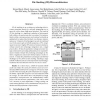Free Online Productivity Tools
i2Speak
i2Symbol
i2OCR
iTex2Img
iWeb2Print
iWeb2Shot
i2Type
iPdf2Split
iPdf2Merge
i2Bopomofo
i2Arabic
i2Style
i2Image
i2PDF
iLatex2Rtf
Sci2ools
MICRO
2006
IEEE
2006
IEEE
Die Stacking (3D) Microarchitecture
3D die stacking is an exciting new technology that increases transistor density by vertically integrating two or more die with a dense, high-speed interface. The result of 3D die stacking is a significant reduction of interconnect both within a die and across dies in a system. For instance, blocks within a microprocessor can be placed vertically on multiple die to reduce block to block wire distance, latency, and power. Disparate Si technologies can also be combined in a 3D die stack, such as DRAM stacked on a CPU, resulting in lower power higher BW and lower latency interfaces, without concern for technology integration into a single process flow. 3D has the potential to change processor design constraints by providing substantial power and performance benefits. Despite the promising advantages of 3D, there is significant concern for thermal impact. In this research, we study the performance advantages and thermal challenges of two forms of die stacking: Stacking a large DRAM or SRAM...
Die Stacking | DRAM | Hardware | MICRO 2006 | Multiple Die |
Related Content
| Added | 12 Jun 2010 |
| Updated | 12 Jun 2010 |
| Type | Conference |
| Year | 2006 |
| Where | MICRO |
| Authors | Bryan Black, Murali Annavaram, Ned Brekelbaum, John DeVale, Lei Jiang, Gabriel H. Loh, Don McCaule, Pat Morrow, Donald W. Nelson, Daniel Pantuso, Paul Reed, Jeff Rupley, Sadasivan Shankar, John Paul Shen, Clair Webb |
Comments (0)

